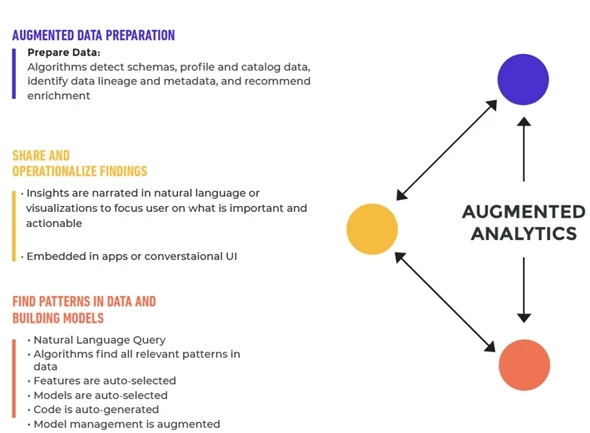In the age of big data and information overload, the field of analytics has seen a significant transformation. Traditional analytics, while valuable, often required expert data scientists to derive insights from complex datasets. However, the advent of augmented analytics is changing the game by making data analysis accessible to a broader range of users and enabling data-driven decision-making like never before.
Defining Augmented Analytics:
Augmented analytics is a technology-driven approach that integrates artificial intelligence (AI) and machine learning (ML) into the analytics process. The primary goal is to enhance data preparation, analysis, and sharing, making it easier for users, regardless of their technical expertise, to explore and analyze data effectively.
The Key Components of Augmented Analytics:
Automated Data Preparation: Augmented analytics tools often include features that automatically clean, transform, and prepare data for analysis. This reduces the time spent on manual data wrangling and ensures that data is accurate and ready for analysis.
Natural Language Processing (NLP): NLP capabilities enable users to interact with data using plain language. They can ask questions, issue commands, and receive responses in human-readable language, making it easier for non-technical users to access and analyze data.
Data Visualization: Augmented analytics platforms typically offer advanced data visualization capabilities. Users can create interactive charts, graphs, and dashboards to represent data in a visually compelling and easy-to-understand format.
Predictive and Prescriptive Analytics: Augmented analytics goes beyond descriptive analytics to offer predictive and prescriptive analytics. Machine learning algorithms analyze historical data to make predictions and recommendations, assisting users in making informed decisions.
Automated Insights: Augmented analytics tools often automatically identify significant trends, anomalies, and insights within datasets. This reduces the need for users to have advanced data analysis skills.
The Benefits of Augmented Analytics:
Democratized Data Analysis: Allows business people, not only data scientists, to obtain insights from data. The democratization of data analysis through Augmented Analytics implies that more individuals within an organization may make data-driven choices.
Efficiency and Time Savings: With automated data preparation and insights, users can save significant time on manual data wrangling and analysis, allowing them to focus on decision-making.
Improved Accuracy: Automated processes reduce the risk of human errors in data analysis and preparation, resulting in more accurate insights.
Data-Driven Decision-Making: Augmented analytics empowers organizations to base decisions on data, fostering a culture of data-driven decision-making.
Enhanced Business Performance: Predictive and prescriptive analytics can help organizations make more strategic and informed decisions that can lead to improved performance, cost savings, and better customer experiences.
Use Cases of Augmented Analytics:
Sales and Marketing: Augmented analytics can help sales and marketing teams by providing insights into customer behavior, predicting sales trends, and identifying potential target segments.
Finance: Financial analysts can benefit from augmented analytics by using predictive models to anticipate market changes, assess risks, and make more informed investment decisions.
Healthcare: In healthcare, augmented analytics can help in disease prediction, patient care optimization, and resource allocation in hospitals.
Retail: Retailers can use augmented analytics to analyze customer purchase patterns, optimize inventory, and personalize marketing strategies.
Manufacturing: In manufacturing, augmented analytics can be used for predictive maintenance, quality control, and supply chain optimization.
Challenges and Considerations:
While augmented analytics offers many benefits, there are also challenges to consider:
Data Quality: Accurate and clean data is critical for reliable insights. Organizations need to ensure data quality to make the most of augmented analytics.
Data Privacy and Ethics: The use of AI in analytics raises data privacy and ethical concerns. Organizations must handle data responsibly and in compliance with regulations.
User Training: While augmented analytics is designed to be user-friendly, organizations may need to provide training to users to maximize its potential.
The Future of Augmented Analytics:
Augmented analytics is poised for substantial growth in the coming years. As AI and machine learning technologies continue to advance, augmented analytics tools will become even more sophisticated and accessible to a broader range of users. The democratization of data analysis will empower organizations to harness the full potential of their data.
Moreover, augmented analytics will play a pivotal role in the integration of data-driven decision-making into various industries and business functions. It will transform the way organizations approach problem-solving and decision-making, making it more dynamic, informed, and agile.
Augmented analytics is ushering in a new era of data-driven decision-making. By automating data preparation, enabling natural language interactions, and offering predictive and prescriptive insights, augmented analytics is changing how organizations use data to shape their strategies, improve performance, and enhance customer experiences. As this field continues to evolve, it promises to be a game-changer for businesses seeking to thrive in an increasingly data-centric world.


